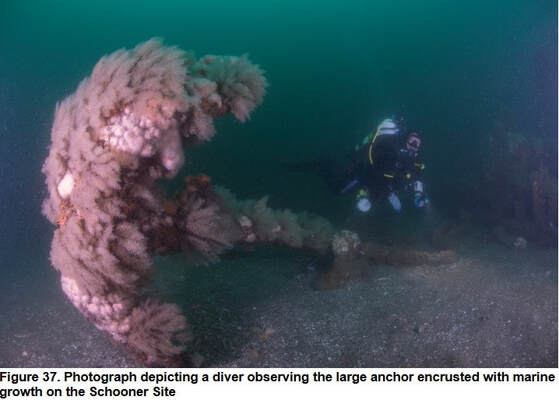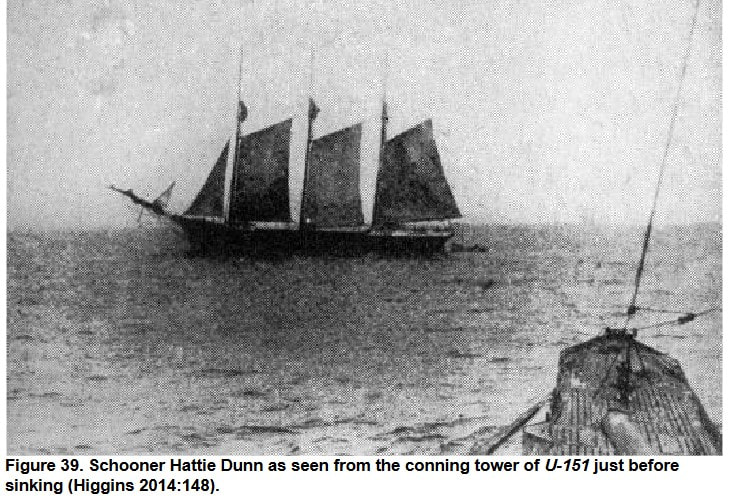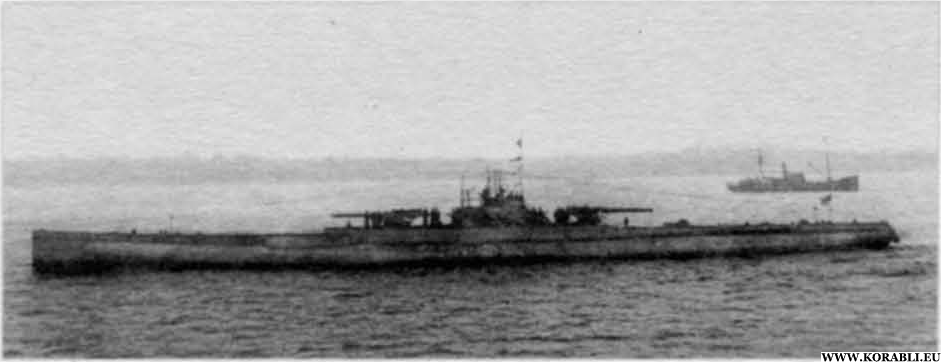Hattie W. Dunn
This is the only known, existing image of the Hattie W. Dunn. The picture was taken by the commander of U-151 from the conning tower of the submarine just before the bombs that sank the schooner were detonated.
On May 25, 1918, off the coast of Assateague Island, Virginia, shortly after 10 am, German U-Boat 151 stopped and scuttled the three-masted, gaff-rigged, wooden schooner Hattie W. Dunn. The United States had entered WWI on April 6, 1917 without much, or any, coastal defense in place. Unarmed merchant ships were easy targets.
Hattie W. Dunn was 145 feet long with a 35 ft beam and about a 12 foot draft. The schooner was constructed of yellow pine and oak with iron and copper fittings. Hattie Dunn had accommodations for seven crew members
U-151 was 213 feet long with a beam of 29 feet and a draft of about 15 feet. The submarine had eight officers and sixty-five enlisted crewmen.
U-151 was the first German submarine to operate in a American waters. It sank a total of twenty-three American vessels along the East Coast during WWI. Hattie Dunn was the first American ship to be sunk in American waters by hostile action since the war of 1812
Hattie W. Dunn was 145 feet long with a 35 ft beam and about a 12 foot draft. The schooner was constructed of yellow pine and oak with iron and copper fittings. Hattie Dunn had accommodations for seven crew members
U-151 was 213 feet long with a beam of 29 feet and a draft of about 15 feet. The submarine had eight officers and sixty-five enlisted crewmen.
U-151 was the first German submarine to operate in a American waters. It sank a total of twenty-three American vessels along the East Coast during WWI. Hattie Dunn was the first American ship to be sunk in American waters by hostile action since the war of 1812
Read Captain Charles E. Hollbrook’s account of the sinking and imprisonment of his seven-member crew at this link.
https://cdnc.ucr.edu/?a=d&d=SDDU19180604.2.10&e=-------en--20--1--txt-txIN--------
https://cdnc.ucr.edu/?a=d&d=SDDU19180604.2.10&e=-------en--20--1--txt-txIN--------
What remains of Hattie W. Dunn has become a coral-encrusted reef. A short video of the wreck is available at this link
https://vimeo.com/11857549
https://vimeo.com/11857549
U-151 had been sent to the east coast of the USA to lay mines at the mouth of the Chesapeake and Delaware Bays and then to interdict shipping near New York harbor. The U-Boat finished its job at the Virginia Capes and was en route to Delaware Bay when it encountered Hattie Dunn.
The Germans boarded Hattie Dunn, took the crew off and placed explosive charges on the ship to sink it. The wreck lies about forty miles off the Assateague Island coast at 37° 40'N, 74° 58'W. The location is approximately fifteen miles south of where Winter-Quarter Lightship was stationed at the time.
The Germans boarded Hattie Dunn, took the crew off and placed explosive charges on the ship to sink it. The wreck lies about forty miles off the Assateague Island coast at 37° 40'N, 74° 58'W. The location is approximately fifteen miles south of where Winter-Quarter Lightship was stationed at the time.

Hattie Dunn was a 414 Gross Registered Ton vessel in ballast headed to Charleston, SC to pick up a load of cotton and deliver that to mills in New England when it encountered U-151. It was the work the “coaster” ship had done since it was launched in 1884 at the yard of Dunn & Elliot in Thomaston, Maine.
The seven-member crew of Hattie Dunn were taken as Prisoners of War on the U-boat. Then U-151 proceeded to sink five more American merchant ships in the next twelve hours. Newspapers of the time called May 12, the the date of the sinkings, “Black Sunday”. The crews of Hattie Dunn, Isabel Wiley and Jacob Haskel were held for eight days before their numbers soon overwhelmed the small quarters of the U-Boat. The men were set adrift in life boats along the coast of New Jersey.
The seven-member crew of Hattie Dunn were taken as Prisoners of War on the U-boat. Then U-151 proceeded to sink five more American merchant ships in the next twelve hours. Newspapers of the time called May 12, the the date of the sinkings, “Black Sunday”. The crews of Hattie Dunn, Isabel Wiley and Jacob Haskel were held for eight days before their numbers soon overwhelmed the small quarters of the U-Boat. The men were set adrift in life boats along the coast of New Jersey.
View a contemporary German, military film of another American gaff-rigged schooner being scuttled
https://tinyurl.com/HattieDunn
https://tinyurl.com/HattieDunn
U-151 survived the war. The British Navy took charge of the vessel and sank the ship soon after the end of the war.
The story of Hattie Dunn is more than a century old. Yet it resonates today because the destructive,
bloody and inhumane act of war is occurring in more than forty places around the world.
Hattie Dunn’s story is a reminder that in war there are no innocents; only targets.
bloody and inhumane act of war is occurring in more than forty places around the world.
Hattie Dunn’s story is a reminder that in war there are no innocents; only targets.
References and Source of Images
Virginia Collaborative Archaeological Survey
OSC study
BOEM 2015-030
Download this fascinating report at this link
www.boem.gov/sites/default/files/renewable-energy-program/State-Activities/HP/VCAS-Report.pdf
US Department of the Interior
Bureau of Ocean Energy Management
Office of Renewable Energy Programs
45600 Woodland Road, Sterling, VA 20160
US Department of Commerce
National Ocean and Atmospheric Administration
Office of Nation Marine Sanctuaries
100 Museum Drive, Newport News, VA 23606
Virginia Collaborative Archaeological Survey
OSC study
BOEM 2015-030
Download this fascinating report at this link
www.boem.gov/sites/default/files/renewable-energy-program/State-Activities/HP/VCAS-Report.pdf
US Department of the Interior
Bureau of Ocean Energy Management
Office of Renewable Energy Programs
45600 Woodland Road, Sterling, VA 20160
US Department of Commerce
National Ocean and Atmospheric Administration
Office of Nation Marine Sanctuaries
100 Museum Drive, Newport News, VA 23606

